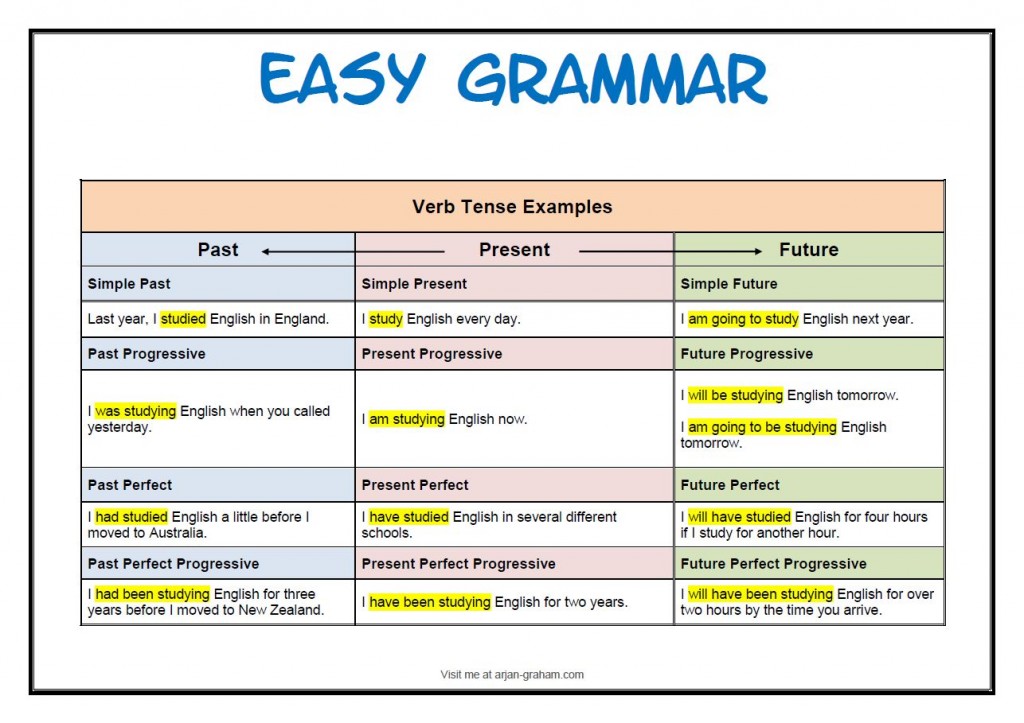Identify the tenses
If you want to try to identify the different tenses, click HERE!
There are twelve tenses in English and each one of them has different verb forms. The biggest problem that students face while using tenses is the inability to conjugate verbs.
English verbs tend to change their forms according to the number and person of the subject. For example, in the simple present tense, the verb takes the marker –s when the subject is a singular noun or pronoun.
In the present continuous tense, the verb takes the auxiliary is when the subject is third person singular noun or pronoun. It takes the auxiliary verb are when the subject is a plural noun or pronoun.
While native speakers pick up these rules easily, they cause a great deal of confusion for an ESL student.
Use this exercise to test your ability to recognize the different tense forms. It is simple. You just need to write the name of the tense against each sentence. Some sentences may be in the passive voice. In that case, you also need to mention that.
1. I have been working on my computer for six hours. (…………………………………………….)
2. She has lived in this street for ten years. (…………………………………………….)
3. I finished the project yesterday. (…………………………………………….)
4. What are you doing there? (…………………………………………….)
5. She had not realized that. (…………………………………………….)
6. Susan will be joining us. (…………………………………………….)
7. Have you ever been to Australia? (…………………………………………….)
8. This house had been destroyed by the fire. (…………………………………………….)
9. The boys were severely reprimanded by their teacher. (…………………………………………….)
10. I had been working in the garden. (…………………………………………….)
11. She will come with us. (…………………………………………….)
12. By this time tomorrow, I will have finished working on it. (…………………………………………….)
Answers
1. I have been working on my computer for six hours. (Present perfect continuous tense – active)
2. She has lived in this street for ten years. (Present perfect tense – active)
3. I finished the project yesterday. (Past simple tense – active)
4. What are you doing there? (Present continuous tense – active)
5. She had not realized that. (Past perfect tense – active)
6. Susan will be joining us. (Future continuous tense – active)
7. Have you ever been to Australia? (Present perfect tense – active)
8. This house had been destroyed by the fire. (Past perfect tense – passive)
9. The boys were severely reprimanded by their teacher. (Past simple tense – passive)
10. I had been working in the garden. (Past perfect continuous tense – active)
11. She will come with us. (Simple future tense – active)
12. By this time tomorrow, I will have finished working on it. (Future perfect tense – active)
Read more at http://www.englishgrammar.org/identify-tenses/#B4SWoMYUDUwa1YXC.99
There are twelve tenses in English and each one of them has different verb forms. The biggest problem that students face while using tenses is the inability to conjugate verbs.
English verbs tend to change their forms according to the number and person of the subject. For example, in the simple present tense, the verb takes the marker –s when the subject is a singular noun or pronoun.
In the present continuous tense, the verb takes the auxiliary is when the subject is third person singular noun or pronoun. It takes the auxiliary verb are when the subject is a plural noun or pronoun.
While native speakers pick up these rules easily, they cause a great deal of confusion for an ESL student.
Use this exercise to test your ability to recognize the different tense forms. It is simple. You just need to write the name of the tense against each sentence. Some sentences may be in the passive voice. In that case, you also need to mention that.
1. I have been working on my computer for six hours. (…………………………………………….)
2. She has lived in this street for ten years. (…………………………………………….)
3. I finished the project yesterday. (…………………………………………….)
4. What are you doing there? (…………………………………………….)
5. She had not realized that. (…………………………………………….)
6. Susan will be joining us. (…………………………………………….)
7. Have you ever been to Australia? (…………………………………………….)
8. This house had been destroyed by the fire. (…………………………………………….)
9. The boys were severely reprimanded by their teacher. (…………………………………………….)
10. I had been working in the garden. (…………………………………………….)
11. She will come with us. (…………………………………………….)
12. By this time tomorrow, I will have finished working on it. (…………………………………………….)
Answers
1. I have been working on my computer for six hours. (Present perfect continuous tense – active)
2. She has lived in this street for ten years. (Present perfect tense – active)
3. I finished the project yesterday. (Past simple tense – active)
4. What are you doing there? (Present continuous tense – active)
5. She had not realized that. (Past perfect tense – active)
6. Susan will be joining us. (Future continuous tense – active)
7. Have you ever been to Australia? (Present perfect tense – active)
8. This house had been destroyed by the fire. (Past perfect tense – passive)
9. The boys were severely reprimanded by their teacher. (Past simple tense – passive)
10. I had been working in the garden. (Past perfect continuous tense – active)
11. She will come with us. (Simple future tense – active)
12. By this time tomorrow, I will have finished working on it. (Future perfect tense – active)
Read more at http://www.englishgrammar.org/identify-tenses/#B4SWoMYUDUwa1YXC.99
